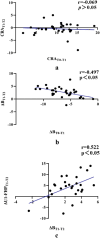Stability of maxilla after segmental Le Fort I osteotomy combined with anterior maxilla clockwise rotation in patients with maxillary hypoplasia: a retrospective study
- PMID: 40426151
- PMCID: PMC12107807
- DOI: 10.1186/s12903-025-06057-4
Stability of maxilla after segmental Le Fort I osteotomy combined with anterior maxilla clockwise rotation in patients with maxillary hypoplasia: a retrospective study
Abstract
Background: Segmental Le Fort I osteotomy combined with anterior maxillary clockwise rotation has been proposed as an effective treatment for maxillary hypoplasia. However, the stability of maxilla after the operation remains unknown.
Methods: A total of 30 patients undergoing segmental Le Fort I osteotomy were retrospectively included. The follow-up period was more than one year. The stability of anterior maxilla after clockwise rotation was evaluated by cone beam computed tomography (CBCT) performed before surgery (T0), three days after surgery (T1), and at least one year after surgery (T2), respectively. The key parameters were the postoperative relapse of the anterior maxillary clockwise rotation angle (CRA) and paranasal advancement.
Results: Following segmental Le Fort I osteotomy, the average CRA of the anterior maxilla was 10.02° ± 3.86°, while the mean paranasal advancement was 6.22 ± 1.40 mm. At the one-year follow-up, the relapse of CRA and paranasal advancement were -0.42° ± 2.51° (p = 0.951) and -0.28 ± 0.83 mm (p = 0.08), respectively, suggesting good postoperative stability. Additionally, no significant correlation was found between the intraoperative CRA and its relapse over time.
Conclusion: Segmental Le Fort I osteotomy combined with anterior maxillary clockwise rotation demonstrates favorable stability up to one year postoperatively, making it a reliable approach for the treatment of maxillary hypoplasia.
Keywords: Anterior maxillary clockwise rotation; Maxillary hypoplasia; Segmental Le Fort I osteotomy; Stability.
© 2025. The Author(s).
Conflict of interest statement
Declarations. Ethics approval and consent to participate: This study was approved by the Institutional Review Board of the Stomatology School of Peking University (PKUSSIRB202278111) and performed in accordance with the 1964 Helsinki Declaration and its later amendment. The informed consent was obtained from all subjects or if subjects were under 18, from a parent and/or legal guardian. Consent for publication: Written informed consent was obtained from the individuals for the publication of any potentially identifiable images or data included in this article. Competing interests: The authors declare no competing interests.
Figures




Similar articles
-
Stability between single and segmental maxillary osteotomies in bimaxillary surgery for cleft-associated class III deformity: a CBCT study.Clin Oral Investig. 2024 May 22;28(6):331. doi: 10.1007/s00784-024-05704-4. Clin Oral Investig. 2024. PMID: 38775989
-
Three-dimensional Analysis of Skeletal Stability in Cleft Lip and Palate Patients Undergoing Bimaxillary Surgery With Le Fort I Osteotomy and Intraoral Vertical Ramus Osteotomy.J Craniofac Surg. 2024 Oct 1;35(7):2088-2092. doi: 10.1097/SCS.0000000000010506. Epub 2024 Oct 1. J Craniofac Surg. 2024. PMID: 39418508
-
Effects of Le Fort I Osteotomy on the Nasopharyngeal Airway-6-Month Follow-Up.J Oral Maxillofac Surg. 2016 Feb;74(2):380-91. doi: 10.1016/j.joms.2015.06.172. Epub 2015 Jul 2. J Oral Maxillofac Surg. 2016. PMID: 26188102
-
Long-term skeletal stability after maxillary advancement with distraction osteogenesis using a rigid external distraction device in cleft maxillary deformities.Plast Reconstr Surg. 2004 Nov;114(6):1382-92; discussion 1393-4. doi: 10.1097/01.prs.0000138593.89303.1b. Plast Reconstr Surg. 2004. PMID: 15509923 Review.
-
Blindness as a complication of Le Fort I osteotomy for maxillary distraction.Plast Reconstr Surg. 2002 Feb;109(2):688-98; discussion 699-700. doi: 10.1097/00006534-200202000-00041. Plast Reconstr Surg. 2002. PMID: 11818854 Review.
References
-
- Peiró-Guijarro MA, Guijarro-Martínez R, Hernández-Alfaro F. Surgery first in orthognathic surgery: a systematic review of the literature. Am J Orthod Dentofacial Orthop. 2016;149(4):448–62. 10.1016/j.ajodo.2015.09.022. - PubMed
-
- Gill FBNDS. Orthognathic surgery: principles, planning and practice. New York: John Wiley & Sons Ltd.; 2017.
-
- Ma H, Li W, Xu L, Hou J, Wang X, Ding S, Lv H, Li X. Morphometric evaluation of the alveolar bone around central incisors during surgical orthodontic treatment of high-angle skeletal class III malocclusion. Orthod Craniofac Res. 2021;24(1):87–95. 10.1111/ocr.12408. - PubMed
-
- Hernández-Alfaro F, Guijarro-Martínez R. On a definition of the appropriate timing for surgical intervention in orthognathic surgery. Int J Oral Maxillofac Surg. 2014;43(7):846–55. 10.1016/j.ijom.2014.02.007. - PubMed
MeSH terms
Grants and funding
LinkOut - more resources
Full Text Sources

